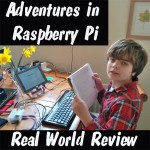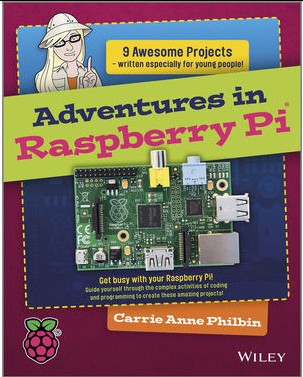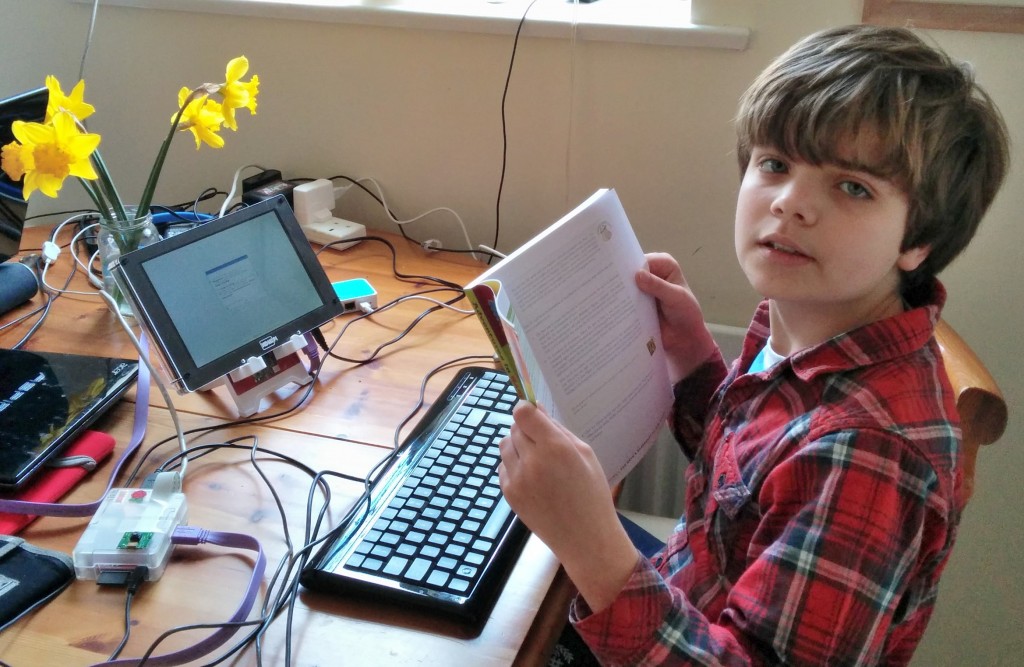
General Observations
Adventures in Raspberry Pi is a 144 page book written to encourage teenagers into real computing by an experienced teacher, Carrie Anne Philbin.
This book makes wonderful use of lots of graphics and screenshots. It’s very nicely laid out with plenty of colour and white space. The pages are all visually interesting and the text clearly explains things in a friendly manner.
But it’s more than that. By being easy to follow and fun to read, the learning will sneak up on you. By breaking everything up into logical bites and taking them one at a time, fundamental programming techniques and terminology are being introduced, almost by stealth. You can see Carrie Anne’s classroom experience in this approach.
Playful, But Not Dumbed Down
By making it playful, rather than tedious, children are given the chance to find out that learning their way around Linux and programming can be rather good fun, limited only by their imagination.
At the same time, it doesn’t hide or protect the reader from the fact that instructions have to be correctly followed if they are to work. (A very important lesson in itself.)
Complete Introduction For Teens
The book is a complete introductory package for teens who are new to the Raspberry Pi. It leads you all the way from connecting the Pi together and flashing an SD card, and finishes with a hardware project – a rather cool MP3 jukebox. On the way it takes in…
- Connecting up the Pi
- Putting NOOBS on an SD card
- Linux basics
- Programming in Scratch, including creating a graphical adventure game
- Python fundamentals, by way of a text-based adventure game
- Using Minecraft Pi Edition to create things with Python
- Making computer music with Sonic Pi
- Controlling LEDs and using buttons and marshmallows as inputs to control a game
- Making an MP3 Jukebox with LCD screen and button controls
The Bad Bits?
Nothing much to moan about, really. Impressively few typos.
I’d say the base font is smaller than my 44-year-old eyes would like, but it’s aimed at young people, so that’s probably not much of an issue for the target audience. And I did manage to read it OK, I just prefer font sizes to be at least 12 points. Other Wiley books are the same.
Overall?
I’ve been teasing Carrie Anne on Twitter about “marking your homework”, since before publication. Finally, the results are in…
It’s got to be an A*, without a doubt.
It’s a wonderful book. It’s educational and fun, which beautifully sums up the essence of Raspberry Pi.
Where Can I Buy One?
Although the RRP is £14.99, you can buy Adventures in Raspberry Pi for a very good price (£6) from the Raspberry Pi Swag store
But It Doesn’t End There!
You know how nothing your parents do can possibly be cool or right? My parents were both History teachers and I dropped History at my earliest convenience. I still find it deadly boring. You can’t imagine how many museums we went to as kids.
My son, Tomek (11), has seen me messing about with Raspberry Pis continually for nearly two years. Add to that the fact that I teach ICT half a day a week at his school. He was in my year 5 class two years ago. You can see where this is headed, right?
We’ve had a couple of abortive attempts to get him programming in Python during that time. We tried “Hello World!” by Warren & Carter Sande, which suited me very well, but didn’t grab Tomek quickly enough, when he was 9/10.
Maybe it paved the way a bit? Maybe not? In any case, we gave Tomek a copy of Adventures in Raspberry Pi at Christmas. I had Carrie Anne sign it at the December #CamJam, where we are both regulars. He had a brief go with it, just after Christmas, with a Pi rigged up on our main TV. He found that a frustrating experience. It was partly my fault, as I had already pre-installed Minecraft Pi in a different directory, so the instructions in the book didn’t quite match. If you flash a new NOOBS or the latest Raspbian and follow the book it all works perfectly. So that was abortive attempt #3. I kind of gave up pressing at that point, not wanting to put him off for life. (It has to be what they want, not what you want, right?)
It Just Happened
But I’ve been reading my copy of Adventures in Raspberry Pi over the last week or two (in my non-existent spare time) in preparation for this review, which I have been woefully slow at delivering. Tomek picked it up the other day and was flicking through it. He’d heard the Flight of the Bumblebee demo I did with Sonic Pi, a while back, and fancied a go at Sonic Pi himself.
But this time, we did things differently. He wanted to do it all “properly, the way it is in the book, so it works like it should”. I also figured we’d make it a bit special and let him use the one and only Pimoroni-cased, working prototype of HDMIPi. (It’s the only one in the world, and yes, I made sure he knew it.) This meant he could sit comfortably at the table and work through the book. I had to catch him by surprise for this photo as he’s at the ‘reluctant to be photographed’ (st)age…
He’s just spent all his available free time this weekend working through the book. It’s been a very positive experience for him. Yes, he has asked me for help a few times. He is at the young end of the target audience, although he’s quite bright for his age.
He’s now about two thirds of the way through the book. He’s done a very good Star Wars theme tune in Sonic Pi, and broke off part way through the Python text adventure game to get creative with his own game (and it worked) YAY^2. (Once they start using what they’ve learnt to get creative and do their own thing, you’ve won. But don’t tell them that!)
Here’s the audio from Tomek’s Sonic Pi Star Wars rendition. It starts off perfectly but last part isn’t finished yet.
Why Did it Click This Time?
He also told me “it’s a very good screen” YAY^3. I think all three elements contributed here…
- His past experience
- The excellent book to follow
- Having a decent dedicated screen that didn’t interfere with anybody else
…that and the fact that he felt like it. It was his idea and he wanted to do it. Having an attractive book lying around to catch his attention can’t have hurt though. I’m not sure quite how I’m going to tell Dave that we’ve lost our priceless HDMIPi prototype though. ;)
What Next?
So we’re a step further. He loves soldering. I rather think he might be a hardware man, but you need to know a bit of software too. But whatever he wants to be, a bit of computational thinking will help him get there. And this weekend working through Adventures in Raspberry Pi could be a vital turning point in shaping his future. Thank you so much Carrie Anne. Adventures in Raspberry Pi is a wonderful book.
23 August 2018 Edit to add It’s GCSE results day and Tomek not only lobbied the school to put on computer science especially for his year-group (they’ve never done it before) but he also got a 7 (equivalent A in ‘old money’) along with an excellent set of results in all other subjects. YAY!


This is why I like e-books…the shipping for the book to the Netherlands is 1.5 x the price of the actual book. Ordered it anyway. Let’s see what my 11 year old thinks of it. He should be OK with reading English (we have to thank the cartoon network and Minecraft for that).
I think there’s a kindle version too, but a physical book is better at the computer, I think. Isn’t there a branch of Amazon in NL? Perhaps it would be cheaper overall?
Nope, no Amazon in the NL (yet), there is a Kindle version indeed (see: http://www.amazon.co.uk/Adventures-Raspberry-Carrie-Anne-Philbin/dp/1118751256) which is cheaper. It wasn’t that I wasn’t willing to pay the final 14 GBP it now costs via the Swag store (I ordered it). Judging by your review it is more than worth that. I thought it was just a shame that most of that money goes to the people shipping it instead of the people creating it.
I don’t know exactly how it works in paper publishing (I’ve been in e-publishing since 1999) but I think the author gets a fixed royalty per copy.
I’m amazed there’s no amazon in NL.
They ship both paper books and Kindles from either Germany or the UK, but I guess we are just a bit too small for them. :-)
Lovely review. So glad Tomek is taking to it. I love Carrie Anne’s book – its just what kids need and is a great example of a teacher writing about things she knows.
I think it wins out because, once you’ve got the basics learnt, you can dip in and out of the rest. e.g. Sonic Pi is a self-contained chapter. As long as you can start it and get sound output working, you’re sorted.
The problem with Hello World! was that, for a 9-year-old’s attention span (2 years ago) you had to do a bit too much learning before the really fun stuff kicked in. I think maybe Scratch is a better entry-point for that age-group.
I’m so glad to have got him over the initial hurdles and frustration barriers. Persistence is such an important life skill, but you need some kind of achievement at some point in order to keep going. Free, high quality games are just a couple of clicks away these days. I can remember playing Manic Miner for weeks and being stuck on level 5 (Eugene’s lair) for days. Most kids wouldn’t do that now, they’d go to another site and find another game instead of learning how to overcome.
I used to save up for a month or two to afford a new game. The first game I ever bought was Cosmiads (a Commodore Pet Galaxians clone with really crap graphics). Most of that has disappeared now, along with the values and skills it taught as a side-effect.
Lovely review. I hope a good book comes along to help old, burnt out coders like me (stopped programming 18 years ago) to go back to the noble art! I have a couple of Python books for the Rasp Pi and the Learn Python the Hard Way. Any ideas on which may be the best?
I used Learn Python the Hard way online to start with, then we got ‘Hello World’ and I found that a useful reference.
Now I’ve got Alex Bradbury & Ben Everard’s ‘Programming in Python with the Raspberry Pi’, which is next up for review.
I still haven’t learnt about things like modules and classes yet, but feel this new book will take me there.
Thanks! I will try following your route, as I have all three of them. Cheers!